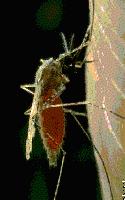![]()
Malaria is an infection caused by the malaria parasite entering the bloodstream. The parasite may gain entry through the bite of an infected mosquito or infected blood transferred by blood transfusion or a contaminated injection needle.
 There are 4 species of malaria parasites:
There are 4 species of malaria parasites:
Plasmodium parasites enter the bloodstream usually after a bite from the anopheles mosquito. The parasites pass through the liver. In the case of vivax and ovale they may lie dormant in the liver for months or years accounting for late relapses.Relapses of this nature from the liver do not occur with falciparum or malariae but chronic infection in the blood may persist for a few years.
Once released from the liver the parasites invade the red blood cells. A cycle of 48 hours is required for falciparum,vivax and ovale and 72 hours for malariae for division and change.After this time they damage the red blood cell and are liberated. They then invade uninfected red cells and start dividing again thus repeating the cycle.At the time of rupture of the red cell they release substances called pyrogens which cause the symptoms of malaria.
Falciparum malaria- (malignant tertian malaria)
The time of onset of the first symptom after the mosquito bite is 7-14 days but may be later if one has been on prophylaxis. Symptoms are variable depending on age,immunity,general health and other factors.
Symptoms
The infected person feels generally unwell with fever,muscle pains and headache rather as if getting flu. Even when outside temperature is hot shivering suddenly starts and becomes a rigor (violent shaking and teeth chattering). The rigor lasts about an hour followed by general prostration,multiple symptoms including throbbing headache and vomiting and the temperature reaches a peak. A drenching sweat breaks out and the fever goes down over a few hours. The total duration of the paroxysm is 8-12 hours and after it the patient may feel well. the classical periodicity of fever of 48 hours is not usually seen with Falciparum malaria and the fever may be daily or unremitting .
Cerebral malaria which occurs with Falciparum is one of the most severe forms of malaria and accounts for 80% of deaths. The term is usually restricted to patients with unrousable coma and falciparum infection.
Vivax, ovale and malariae
The incubation periods are different in the 3 types of malaria varying from 12-17 days in vivax to 18-40days in malariae. Some strains of vivax may have long incubation periods 250-637 days.
Symptoms
The characteristic tertian interval between fever spikes may be seen with vivax and ovale (48hour interval) and the quartan interval with malariae (72hours) This periodicity is established after some days of irregular fever.
Paroxysmal fevers as described for falciparum occur but there is a low mortality and cerebral malaria is rare. The spleen may become very enlarged with malariae infection. Patients with vivax infection may become severely anaemic.
Diagnosis
Malaria must be suspected in any person returning from a malaria area who develops fever and feels unwell. It must be remembered that malaria may be transmitted by a stopover at an airport or other location where one may be in contact with an infected mosquito.It may also occur after transfusion with infected blood or injection with an infected needle. Repeated thick and thin blood smears must be done. The smears should be looked at by a person familiar with looking for the parasite under the microscope.
Treatment
Chemotherapy must be started as soon as possible particularly in falciparum malaria. The therapy is best given by intravenous route usually in a drip infusion but oral therapy must be started at once and continued until I-V therapy can be started.
Chloroquine is still the most commonly used treatment in areas where the parasite remains sensitive to the drug.
Quinine may be the only effective treatment for chloroquine resistant falciparum malaria.
Sulphonamide-pyrimethamine combinations eg Fansidar A single dose of 3 tablets may be used as emergency standby treatment if out of reach of medical facilities. Resistance is developing and spreading.Patients with sensitivity to sulphonamides may develop severe reactions.
Other antimicrobial drugs.
May be used In an emergency. Although they have some antimalarial activity they are usually only effective if used with quinoline compounds. These drugs are erythromycin,tetracycline,clindamycin and cotrimoxazole.
General measures
Patients should be nursed in bed as there is a tendency to develop low blood pressure.Temperatures may be controlled by fanning,tepid sponging or antipyretic(temperature lowering) drugs such as paracetamol.
Prognosis
The mortality of vivax,ovale and malariae is very low. Cerebral malaria (falciparum in most cases) has a mortality which may be 20% or more.
Malaria prophylaxis
Chloroquine and Proguanil are still recommended. For areas where chloroquine resistance is known a decision as to what is the best chemoprophylaxis must be discussed with a Doctor who has up to date knowledge of current recommendations and problems with prescribed antimalarial drugs. The debate about Mefloquine continues as it is one of the most effective drugs in sub-saharan Africa where chloroquine resistance is very common. Mefloquine has known neuropsychiatric side effects and these have to be weighed against the dangers of contracting falciparum malaria. General measures are very important as one should not rely totally on chemotherapy.
Protective Measures
Prophylaxis in children as in adults is to use nonpharmacologic protective strategies. Because of rare reports of toxic encephalopathy and seizures,repellents containing DEET should be used judiciously in children. They should be applied to exposed clothing but not to mucous membranes,open wounds or hands.Repellents should be washed off when children come indoors to protected areas.
1 Oxford Textbook of Medicine 2nd Edition edited by DJ Weatherall JGG Ledingham DA Warrell Malaria by DJ Bradley CI Newbold DA Warrell.
2 Longworth DL, "Drug resistant malaria in children and in travelers," Pediatric Clinics of North America 42(3) (Jun 1995): 649-64.
All pages copyright ©Priory Lodge Education Ltd 1994-1999.